lan network
ip subnet calculator
lan ip address subnetwork (it remanis same)
10.0.0.0 - 10.255.255.255 255.0.0.0
172.16.0.0 - 172.31.255.255 255.255.0.0
192.168.0.0 - 192.168.255.255 255.255.255.0
wireless network.doc (136,5 kB)
Default gateway & DNS server IP assigning..doc (136,5 kB)
How to assign IP Addresses to the client & server.doc (121,5 kB)
set up a wired network.doc (567,5 kB)
wirless network connection.doc (578 kB)
Connect computers in different rooms to the Internet.doc (201,5 kB)
Set up a wireless network without a router.doc (272,5 kB)
Although you can buy cables at specific lengths (e.g. 2 metres, 5 metres, 10 metres, etc) in shops, or even buy them to your specified measurements, it is often easier to make them yourself. This way you can make them to the required length.
Here I have explained how to make cables for UTP (RJ45)
UTP RJ45
What you will need:
- Length of the UTP (Unshielded Twisted Pair) cable (e.g. xx metres)
- RJ45 Plugs
- RJ45 cable boots (1 for each RJ45 plug) - not essential but preffered as they re-enforce the fitting of the cable into the RJ45 plug
- RJ45 Crimp Tool
The RJ45 plugs should have the following wire order: (where pin 1 is on the left when you look at the RJ45 plug from behind and it is upside down - i.e. the latch that sticks out is pointing down and towards you)
| Patch Cable | Crossover Cable | |||
|
EIA/TIA 568B Wiring Standard |
Crossover Cable Wiring Wire one end of the cable using the patch cable ordering and the other end like this (i.e. swap pins 2 and 6): |
|||
| PIN | Wire Colour | PIN | Wire Colour | |
|
1
|
White with Orange Stripe |
1
|
White with Green Stripe | |
|
2
|
Orange with White Stripe |
2
|
Green with White Stripe | |
|
3
|
White with Green Stripe |
3
|
White with Orange Stripe | |
|
4
|
Blue with White Stripe |
4
|
Blue with White Stripe | |
|
5
|
White with Blue Stripe |
5
|
White with Blue Stripe | |
|
6
|
Green with White Stripe |
6
|
Orange with White Stripe | |
|
7
|
White with Brown Stripe |
7
|
White with Brown Stripe | |
|
8
|
Brown with White Stripe |
8
|
Brown with White Stripe | |
To make the cables:
- Cut the cable to length
- Strip the ends of the cable (the crimp tool will probably have a wire stripping gizmo on it to strip the wires to the right length)
- Put the RJ45 cable boots onto the cable (you do not actually need these, but they do serve three purposes:- They look good, they help prevent damage to the cable from bending just behind the RJ45 plug and if you use different coloured boots, they can help identify which cable in the hub the individual wires into the RJ45 plugs (in the order shown in the tables above)
- Use the crimp tool to crimp the wires into the plug. double check that the wires are in the correct order, have been crimped properly, etc.
Windows 95/98/Me | Windows NT (soon) | Windows 2000 | Windows XP | Others (maybe later)
Here I will talk about how to set up a LAN in Windows 95/98/Me.
once you've set up your hardware (i.e. slotted in the network card and connected all of the computers - actually you don't have to connect to another computer at this stage, but you must have installed the network card) boot up your computer (for instructions on installing your network card, see the instructions that come with it).
Chances are the network card you have is PnP (Plug and Play) compatible. If so Windows should detect the network card and (provided you follow the on screen instructions correctly) complete the installation process (it probably gave your network card the Realtek drivers). Your computer may rebooted automatically to complete the installation process.
Upon loading Windows, you will be asked for your name and password. Type in a name and press OK(do not enter a password - you can do that later if you want).
Right click on the Network icon that has now appeared on your desktop and select properties.
To make things easier, we'll deal with the Identification tab first.
Select the Identification tab by clicking on it. You will be presented with the following screen:
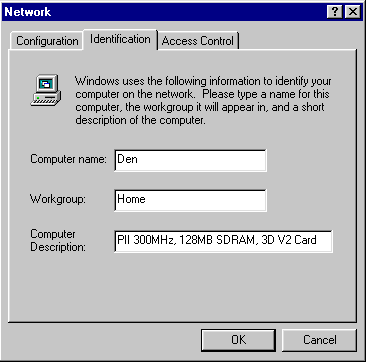
Enter the appropriate information. Note - the computer name must be unique for each computer but the computer description can be blank/same/different for each computer. The Workgroup must be the same for each computer that wants to belong to a particular network. You can have several logical networks connected by the same physical network (i.e. cables)!
Now go back to the Configuration tab.
In here you may already have a Dial-Up Adapter (an adapter) if you have a modem and an Internet connection. If so then you'll also have the TCP/IP -> Dial-Up Adapter (a protocol) displayed. As these are just for the Internet, you can ignore them (i.e. don't edit or delete them).
Also in this box will be another adapter and another protocol relating to the adapter. This will have been set up during the previous boot-up when Windows installed and configured your new network card. The adapter may say something like Realtek RTL8029 PnP Ethernet Adapter and will have the protocol IPX/SPX-compatible Protocol -> Realtek RTL8029 PnP Ethernet Adapter.
NOTE - the protocols may not be listed as [PROTOCOL] -> FOR ADAPTER XXXX as this is not needed if there is only one adapter. In which case it will simply list the protocol being used.
Here is an example of the configuration tab:
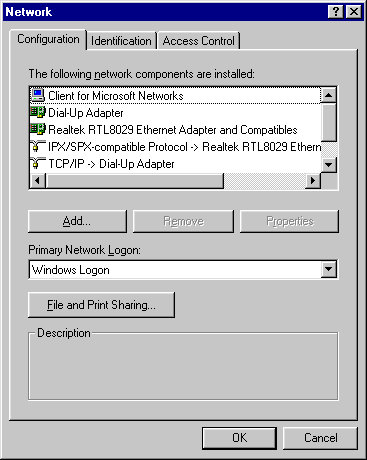
The first thing you should do here is ensure that the Primary network Logon is set to Windows Logon. This means that you do not need to enter a password every time you log on.
If you want to other computers on the network to be able to view/access your files and/or use your printer, etc click on File and Print Sharing and then tick the relevant boxes. I recommend that you tick both these boxes for now because even with them ticked, they are still not actually enabled - more on this later...
Now to set up the TCP/IP protocol for the network adapter (required for some games such as Close Combat 2, Half Life, etc).
Click Add | Protocol | Microsoft | TCP/IP
You will now see:
TCP/IP-compatible Protocol -> Realtek RTL8029 PnP Ethernet Adapter
Double click on this to display the following screen:
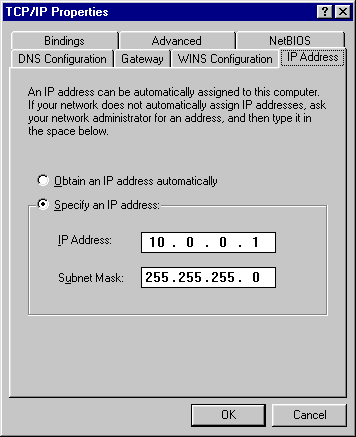
Enter the settings as shown i.e.:
| Specify an IP address | Selected |
| IP Address | 10.0.0.1 |
| Subnet Mask | 255.255.255.0 |
For each computer on the network the Subnet Mask must be the same, but the IP address must be different (or you will get an IP address conflict error) e.g.: 10.0.0.1, 10.0.0.2, 10.0.0.3, etc.
Then go to the Bindings tab and make sure that the Client for Microsoft Networks option is ticked and the File and Printer Sharing for Microsoft Networks option is unticked.
Click on OK to go back to the main network configuration screen.
Click OK again to quit the network configuration screen
Windows will probably ask for the Win 9x CD and will then ask you to restart the computer
Once everyone has restarted their computers, double click on the Network icon on your desktop (also in Explorer). You should now see the names of all of the computers connected to the network. If not, try pres27 February, 2007should be done automatically). If you still can't see everyone, ask EVERYONE to reboot their computer - this is sometimes necessary. if you still can't see everyone's computer, check your settings; you probably overlooked something. For some pointers check out my troubleshooting page.
At this point you can now start playing games with your friends (soon to become mortal enemies!) :-)
However I recommend that you put this off for just a few more minutes and read the following section onfile and printer sharing!
Windows 2000
Here I will tell you how to set up a LAN in Windows 2000.
Once you've set up your hardware (i.e. slotted in the network card and connected all of the computers - actually you don't have to connect to another computer at this stage, but you must have installed the network card) boot up your computer (for instructions on installing your network card, see the instructions that come with it).
Chances are the network card you have is PnP (Plug and Play) compatible. If so Windows should detect the network card and (provided you follow the on screen instructions correctly) complete the installation process (it probably gave your network card the Realtek drivers). Your computer may rebooted automatically to complete the installation process.
Upon loading Windows, you will be asked for your name and password. Type in a name and press OK(do not enter a password - you can do that later if you want).
Right click on the 'My Computer' icon on your desktop and select 'Properties'.
Then select the 'Network Identification' tab and select 'Properties':
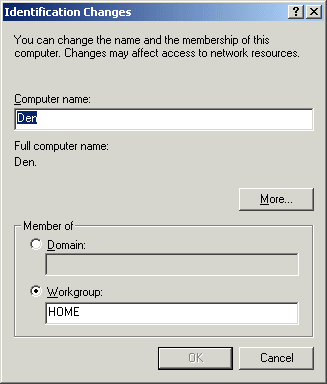
Give your computer a name (I called my PC Den because it is located in a room in my house called the Den).
Give your Workgroup a name (explanation on workgroups and domains coming soon)
Note - the computer name must be unique for each computer but the computer description can be blank/same/different for each computer. The Workgroup must be the same for each computer that wants to belong to a particular network. You can have several logical networks connected by the same physical network (i.e. cables)!
Then press OK
Right click on the 'My Network Places' icon that has now appeared on your desktop and select'Properties'.
Then double click on 'Local Area Connection' to get to this screen:
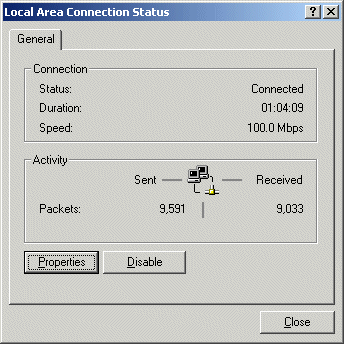
and then select Properties to arrive here:
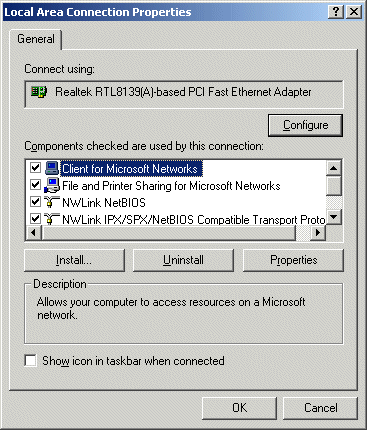
In here you may already have a Dial-Up Adapter (an adapter) if you have a modem and an Internet connection. If so then you'll also have the TCP/IP -> Dial-Up Adapter (a protocol) displayed. As these are just for the Internet, you can ignore them (i.e. don't edit or delete them).
Also in this box will be another adapter and another protocol relating to the adapter. This will have been set up during the previous boot-up when Windows installed and configured your new network card. The adapter may say something like Realtek RTL8029 PnP Ethernet Adapter and will have the protocol IPX/SPX-compatible Protocol -> Realtek RTL8029 PnP Ethernet Adapter.
NOTE - the protocols may not be listed as [PROTOCOL] -> FOR ADAPTER XXXX as this is not needed if there is only one adapter. In which case it will simply list the protocol being used.
To add a protocol or service, just click on the 'Install' button pictured in the screenshot above and then browse to it.
The protocols that you should install are:
- Internet Protocol (TCP/IP)
- NWLink IPX/SPX/NetBIOS Compatible Transfer Protocol
- NWLink NetBIOS
The services that you should install are:
- Client for Microsoft Networks
- File and Printer Sharing for Microsoft Networks (only needed if you want other people on the LAN to browse/open/use files on your computer and access hardware attached to your computer - such as printers. more on this later...)
Now to set up the TCP/IP protocol for the network adapter (required for some games such as Close Combat IV, Half Life, etc).
Click Add | Protocol | Microsoft | TCP/IP
You will now see something like:
Internet Protocol (TCP/IP) -> Realtek RTL8029 PnP Ethernet Adapter
Double click on this to display the following screen:
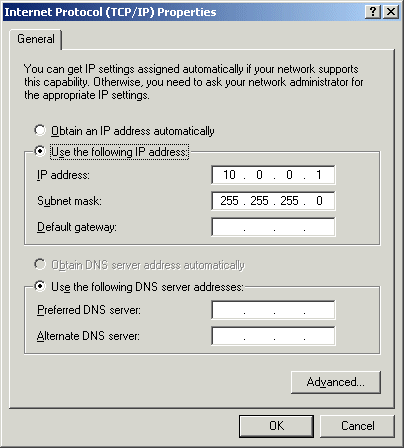
Enter the settings as shown i.e.:
| Use the following an IP address | Selected |
| IP Address | 10.0.0.1 |
| Subnet Mask | 255.255.255.0 |
For each computer on the network the Subnet Mask must be the same, but the IP address must be different (or you will get an IP address conflict error) e.g.: 10.0.0.1, 10.0.0.2, 10.0.0.3, etc.
Click on OK to go back to the main network configuration screen.
Click OK again to quit the network configuration screen
Windows may ask for the Windows 2000 CD and will then ask you to restart the computer
Windows XP
Here I will tell you how to set up a LAN in Windows XP
Once you've set up your hardware (i.e. slotted in the network card and connected all of the computers - actually you don't have to connect to another computer at this stage, but you must have installed the network card) boot up your computer (for instructions on installing your network card, see the instructions that come with it).
Chances are the network card you have is PnP (Plug and Play) compatible. If so Windows should detect the network card and (provided you follow the on screen instructions correctly) complete the installation process (it probably gave your network card the Realtek drivers). Your computer may rebooted automatically to complete the installation process.
Once installed you can either follow the Windows XP networking wizard or set it up manually. The easiest option is to use the wizard - then you can manually tweak it later if you want to.
To start the New Connection wizard either:
- Boot up your PC after installing your new network card - it should then appear
- Insert your Windows XP CD and choose the New network Connection Wizard option
- Start | Control Panel | Network Connections | Create a new connection
This will bring up the network connection wizard screen:
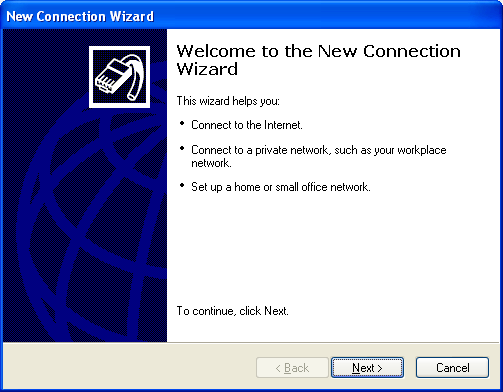
Select Next
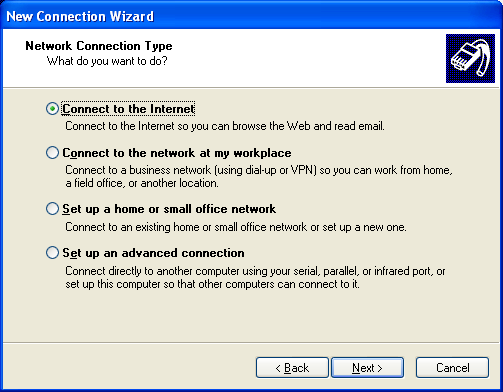
Select the 'Set up a home or small office network' option and then press Next
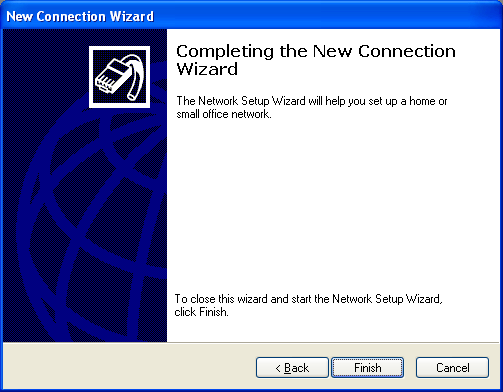
Select Finish to close this Wizard and then open the Network Setup wizard
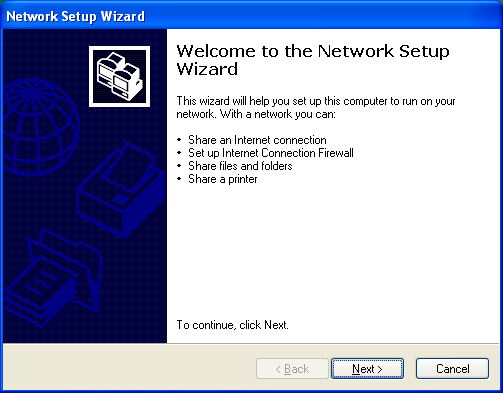
Select Next
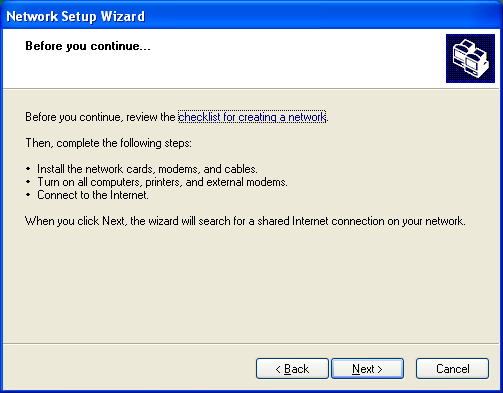
Select Next

Select the required connection method (view the examples if you are unsure).
If you want your computer to connect directly to the Internet, you mucst already have this set up (e.g. a modem, ISDN, ADSL or Cable connection). If not you will asked to set up the connection first before being allowed to continue with this wizard.
If you choose to connect to the Internet via another computer or a gateway, the wizard will search for it later.
Select other if you do not have an available Internet connection or if your PC connects to a hub which in turn connects to an Internet gateway or modem
Then select Next
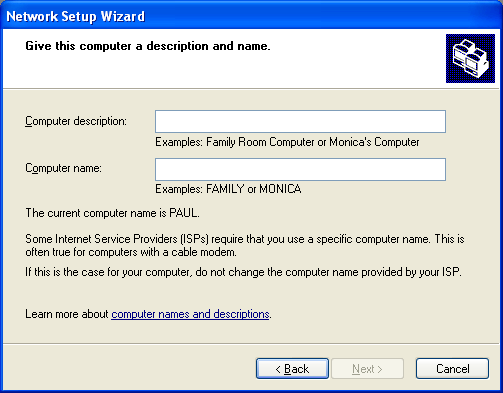
Enter a Computer name and description (optional). Then select Next
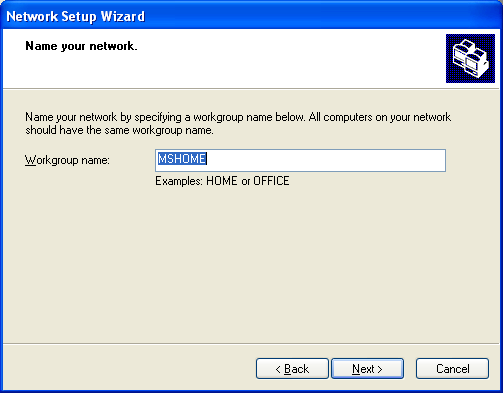
Enter a name for the Workgroup, or accept the default name of 'MSHOME'. Then select Next
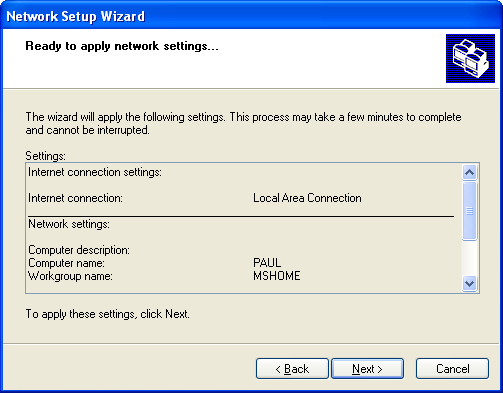
Select Next and Windows will wizz off and set everything up for you!
Once completed, run the wizard on any remaining Windows XP based PCs on the network. With any luck you will have a LAN up and running within 5 - 10 minutes and all of your PCs will be able to connect to the internet!
Now just follow the next few pages of this site to configure your LAN so that you can share files, printers.
Special note if some of the PCs on your LAN are running operating systems other than Windows 2000, NT4 and XP.
In order for people on the other operating systems to view files on your computer you will need to enable the 'guest' account on your computer. This is disabled by default for security reasons. To enable it go to:
Start | Settings | Control Panel | Administrative Tools | Computer Management | Local Users and Groups | Users
Double click on Guest and then un-tick the 'Account is Disabled' checkbox.
All computers on your LAN should now be able to see the files on the PC that you have set up sharing on.
Once everyone has restarted their computers, double click on the Network icon on your desktop (also in Explorer). You should now see the names of all of the computers connected to the network. If not, try pressing the F5 key to refresh your display (although this should be done automatically). If you still can't see everyone, ask EVERYONE to reboot their computer - this is sometimes necessary. if you still can't see everyone's computer, check your settings; you probably overlooked something.
Set up a home network using a router: Part I

